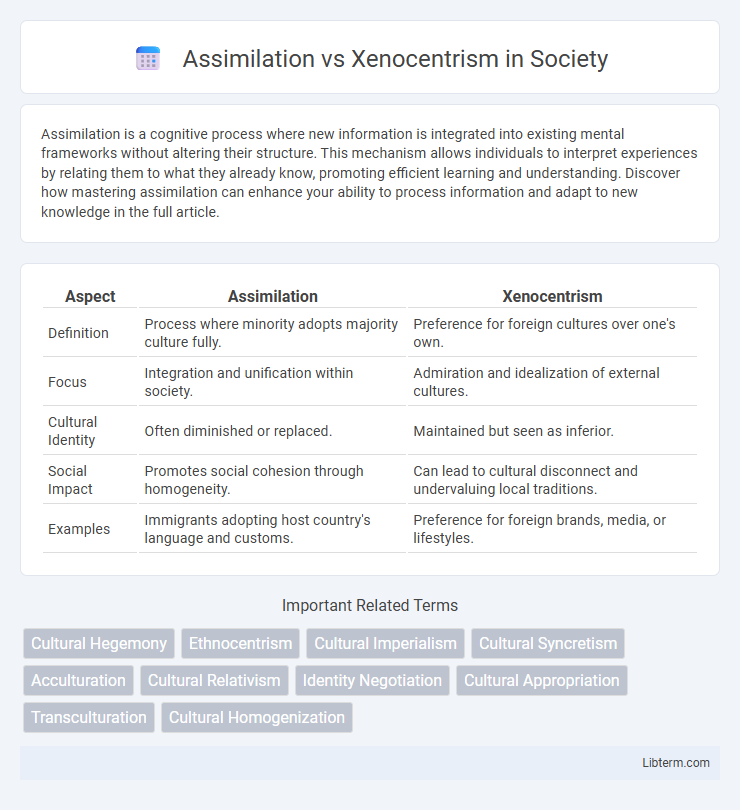Assimilation is a cognitive process where new information is integrated into existing mental frameworks without altering their structure. This mechanism allows individuals to interpret experiences by relating them to what they already know, promoting efficient learning and understanding. Discover how mastering assimilation can enhance your ability to process information and adapt to new knowledge in the full article.
Table of Comparison
| Aspect | Assimilation | Xenocentrism |
|---|---|---|
| Definition | Process where minority adopts majority culture fully. | Preference for foreign cultures over one's own. |
| Focus | Integration and unification within society. | Admiration and idealization of external cultures. |
| Cultural Identity | Often diminished or replaced. | Maintained but seen as inferior. |
| Social Impact | Promotes social cohesion through homogeneity. | Can lead to cultural disconnect and undervaluing local traditions. |
| Examples | Immigrants adopting host country's language and customs. | Preference for foreign brands, media, or lifestyles. |
Understanding Assimilation: Definition and Context
Assimilation refers to the process by which individuals or groups adopt the cultural traits, language, and social norms of another dominant culture, often leading to the gradual loss of their original identity. This concept is crucial in multicultural societies where minority groups integrate into the mainstream culture to achieve social acceptance or economic benefits. Understanding assimilation involves analyzing its impact on cultural diversity, identity preservation, and social cohesion within complex societal frameworks.
What is Xenocentrism? Key Concepts Explained
Xenocentrism refers to the preference for foreign cultures, products, or ideas over one's own, often leading to the perception that external influences are superior. This concept contrasts with assimilation, which involves adopting the dominant culture's norms and values, usually within the same society. Key aspects of xenocentrism include cultural admiration, consumption of foreign goods, and the tendency to devalue local traditions and practices.
Historical Roots of Assimilation and Xenocentrism
Assimilation traces its historical roots to colonial and immigrant societies where dominant cultures imposed their values to unify diverse populations, promoting social cohesion and national identity. Xenocentrism emerged as a cultural response valuing foreign customs and products over native ones, often linked to post-colonial societies critiquing local practices through an idealization of the external. Both concepts reflect complex socio-political dynamics shaping identity and power in multicultural settings.
Cultural Impacts: Assimilation vs Xenocentrism
Assimilation leads to cultural homogenization by encouraging minority groups to adopt the dominant culture's customs and values, often resulting in the erosion of original cultural identities. Xenocentrism, on the other hand, elevates foreign cultures above the native culture, fostering admiration or preference for external customs while potentially undermining local traditions. Both processes significantly influence social cohesion and cultural diversity, shaping identity and intercultural relations in complex ways.
Social Identity and Group Dynamics
Assimilation involves individuals adopting the norms and values of a dominant group to enhance social identity and achieve group cohesion, often at the expense of their original cultural identity. Xenocentrism reflects a preference for the attributes of an out-group, which can create tension within in-group dynamics and challenge traditional social identity frameworks. Both concepts influence group interactions by shaping perceptions of inclusion, belonging, and intergroup relations in multicultural societies.
Benefits and Drawbacks of Assimilation
Assimilation facilitates cultural integration by encouraging individuals to adopt the dominant society's language, values, and customs, promoting social cohesion and reducing cultural conflicts. However, it can lead to the loss of original cultural identity, diminishing diversity and causing feelings of marginalization among minority groups. The benefits of assimilation include improved economic opportunities and social acceptance, while drawbacks encompass cultural homogenization and psychological stress resulting from identity suppression.
Consequences of Xenocentrism in Modern Societies
Xenocentrism in modern societies often leads to diminished cultural self-esteem and identity loss as individuals prioritize foreign customs over their own heritage. This preference can cause internal social divisions and hinder national unity by undermining traditional values and local institutions. Economic consequences arise when consumers favor imported goods excessively, potentially weakening domestic industries and economies.
Assimilation vs Xenocentrism: Key Differences
Assimilation involves adopting the cultural traits of another group, often resulting in the gradual loss of the original culture, whereas xenocentrism is characterized by a preference for foreign cultures over one's own. Key differences include assimilation's emphasis on cultural integration and identity transformation contrasted with xenocentrism's value judgment favoring external cultural practices. Understanding these distinctions is crucial for analyzing social dynamics and cultural identity in multicultural societies.
Case Studies: Real-World Examples
Case studies highlight assimilation as seen in the Americanization of immigrants in the United States, where cultural integration often leads to the adoption of dominant norms and language. Xenocentrism appears in countries like Japan, where foreign products and lifestyles are frequently idealized over domestic alternatives despite strong national identities. These examples illustrate the contrasting impacts on cultural identity and consumer behavior within diverse societies.
Fostering Balanced Cultural Perspectives
Fostering balanced cultural perspectives requires understanding assimilation as the process of integrating into a dominant culture while preserving key elements of one's original identity, contrasted with xenocentrism, which idealizes foreign cultures over the local. Emphasizing cultural pluralism allows individuals to appreciate diverse traditions without diminishing their own heritage, promoting mutual respect and empathy. Educational programs and intercultural dialogue are crucial in mitigating cultural bias, encouraging inclusive environments that value both assimilation and healthy admiration for other cultures.
Assimilation Infographic

 libterm.com
libterm.com